
Religious Practices of the Diegueño Indians, by T.T. Waterman, [1910], at sacred-texts.com

Religious Practices of the Diegueño Indians, by T.T. Waterman, [1910], at sacred-texts.com
PLATES
NOTE: The order of the plates and 'explanations' have been reversed so that the explanation follows the plate. All plates have been arbitrarily resized so the notes on the 'natural size' of the objects are no longer valid.—JBH
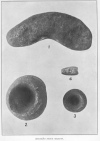
Click to enlarge
Plate 21. DIEGUEÑO STONE OBJECTS
EXPLANATION OF PLATE 21.
Fig. 1.—Crescent-shaped ceremonial stone. Mesa Grande. 1-13747 1.
Fig. 2.—Toloache mortar. Mesa Grande. 1-13742.
Fig. 3.—Stone cup for drinking toloache. Mesa Grande. 1-13743.
Fig. 4.—Stone pipe. Capitan Grande. 1-14474.
Figures are .3 natural size.
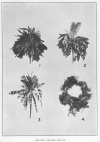
Click to enlarge
Plate 22. DIEGUEÑO FEATHER OBJECTS
EXPLANATION OF PLATE 22.
Figs. 1-3.—Headplumes of owl feathers. Mesa Grande. 1-12963, 1-13751, 1-13750.
Fig. 4.—Headband of owl feathers. Mesa Grande. 1-12962.
Figures are .13 natural size.
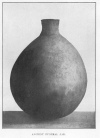
Click to enlarge
Plate 23. ANCIENT FUNERAL JAR.
EXPLANATION OF PLATE 23.
Funeral jar. Found about 15 miles from Mesa Grande. 1-13739.
.11 natural size.

Click to enlarge
DIEGUEÑO GROUND PAINTING.
EXPLANATION OF PLATE 24.
Ground Painting, made by Manuel Lachuso, an old man of Santa Ysabel. He had forgotten the precise location of the milky way, sun, new moon, and old moon, so they are omitted. He made no mention of toloache mortars.
1.—Atoloi, witch mountain on an island, identified by the informant with Coronado island.
2.—Nyapukxaua, mountain where people were created.
3.—Wikaiyai, San Bernardino mountain.
4.—Axatu, Santa Catalina island.
5.—Awī, rattlesnake.
6.—Etcekurlk, wolf.
7.—Xatca, Pleiades.
8.—Namul, bear.
9.—Nyimatai, panther.
10.—"Cross star".
11.—Sair, buzzard star.
12.—Xawitai, grass or blue garter snake.
13.—Xilkaīr, red racer snake.
14.—Awiyuk, gopher snake.
15.—Watun, "shooting" constellation.
16.—Amu, mountain-sheep, three stars of Orion.
17.—Spitting hole, diameter about 8 inches.
18.—Horizon, forming the visible limits of the earth.
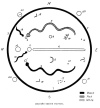
Click to enlarge
DIEGUEÑO GROUND PAINTING.
EXPLANATION OF PLATE 25.
Ground Painting made by Antonio Maces and Jo Waters, old men at Mesa Grande.
1, 2, 3.—Kalmo and witūrt, toloache mortar and pestle.
4, 5.—Awī, rattlesnake.
6.—Xatatkūrl, milky way.
7.—Amut kwaptcurpai, world's edge. There is some doubt as to the correct color for this figure.
8.—Halyaxai, new moon.
9.—Halya, full moon.
10.—Inyau, sun.
11.—Hatapa, coyote.
12.—Saīr, buzzard star.
13.—Crow.
14.—Halturt, black spider.
15.—Katckurlk, wolf.
16.—Amu, mountain-sheep, Orion.
17.—Hatca, Pleiades.
18.—Awī-nīl, black snake.
19.—Awl-yuk, gopher snake.
20-23.—Mountains.
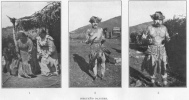
Click to enlarge
DIEGUEÑO DANCERS.
EXPLANATION OF PLATE 26.
Fig. 1.—Women Dancing.
Figs. 2, 3.—Dancers painted for Tapakwirp.
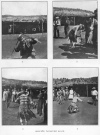
Click to enlarge
DIEGUEÑO TAPAKWIRP DANCE.
EXPLANATION OF PLATE 27.
Fig. 1.—Assistant posing facing the sun in the Tapakwirp dance.
Fig. 2.—Tapakwirp dancer resting. The leader stands at his left.
Fig. 3.—Tapakwirp dancer whirling.
Fig. 4.—Tapakwirp dancer squatting in the midst of a song.
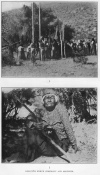
Click to enlarge
DIEGUEÑO KERUK CEREMONY AND MOURNER.
EXPLANATION OF PLATE 28.
By courtesy of Mr. E. H. Davis, Mesa Grande.
Fig. 1.—Poles and materials for the enclosure used in the Keruk ceremony. The women are crying. The old woman on the left is sprinkling pine-nuts and beans over the materials. Photographed in August, 1908.
Fig. 2.—Old woman. Her breast is lacerated as a sign of mourning.
345:1 The numbers given are the catalogue numbers of the Museum of the Department of Anthropology of the University of California.